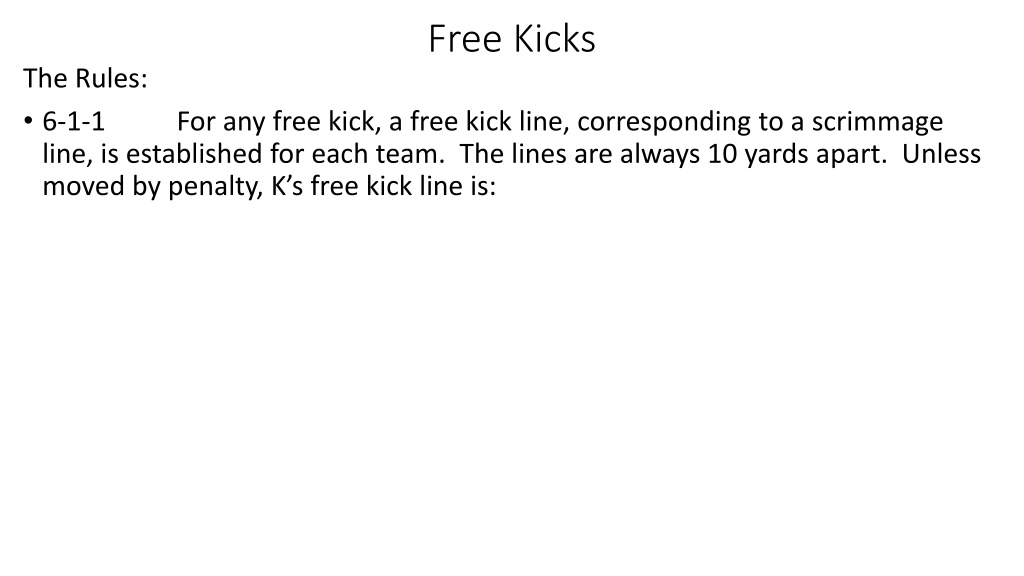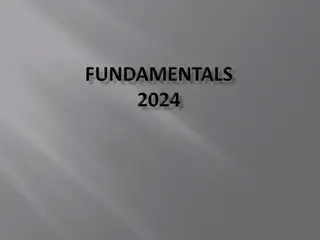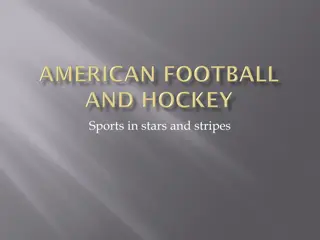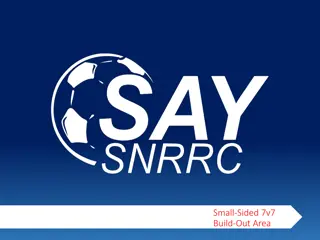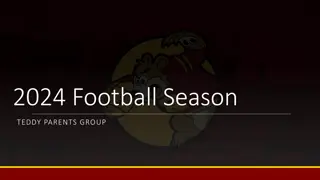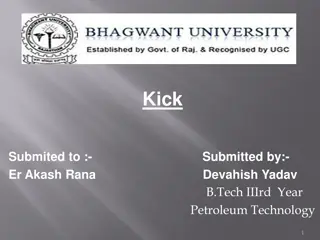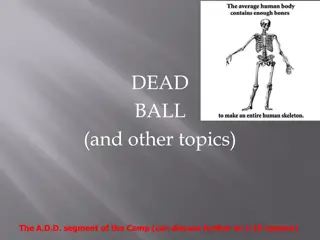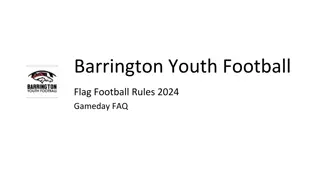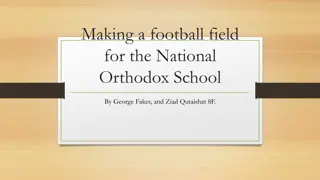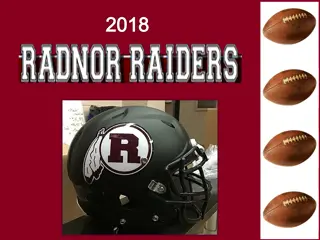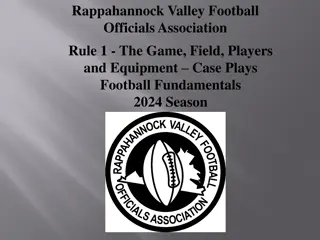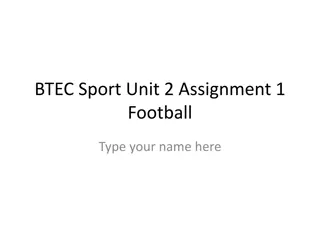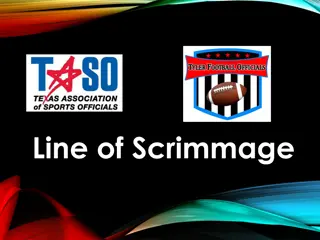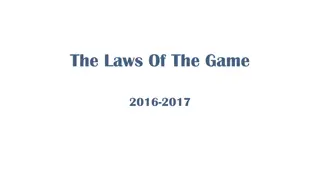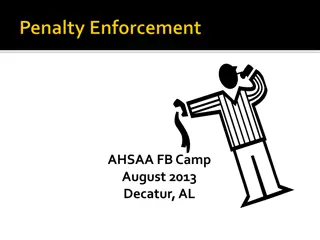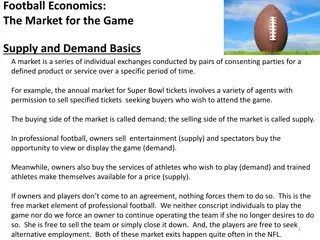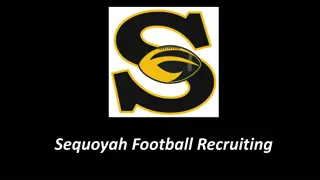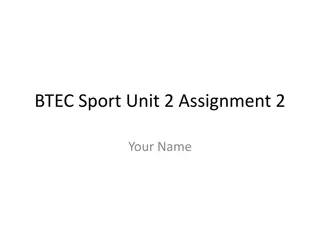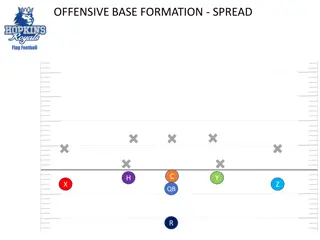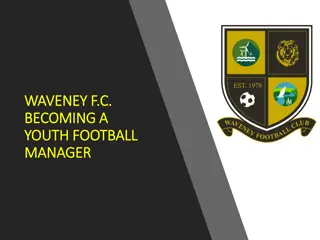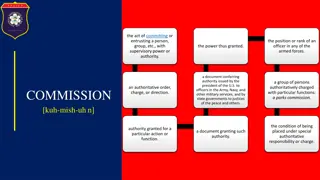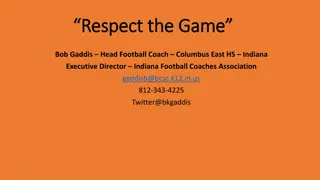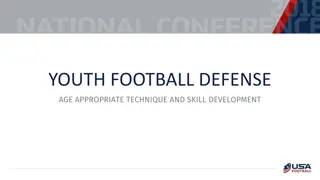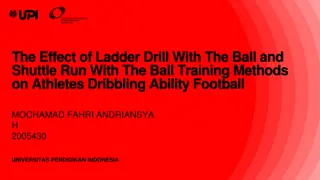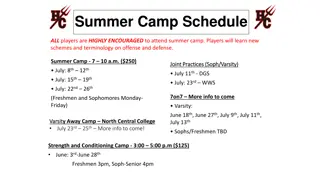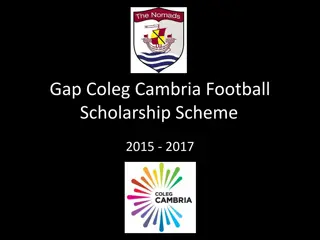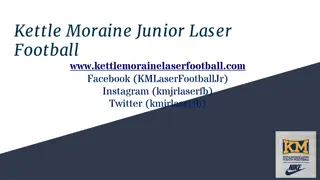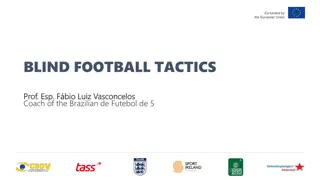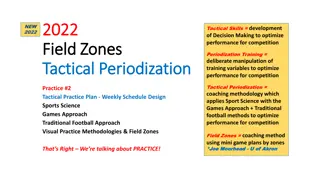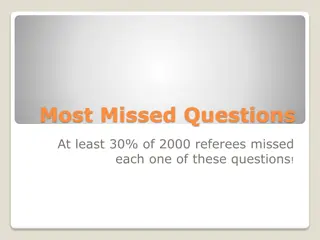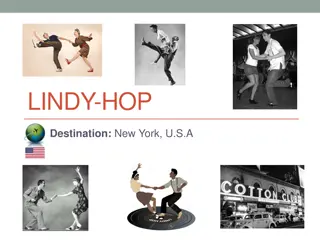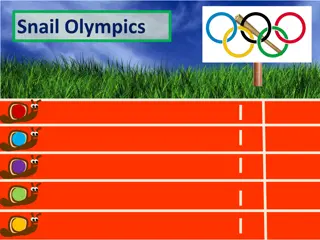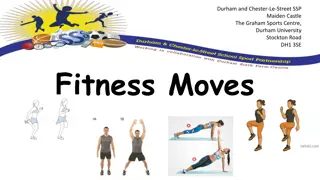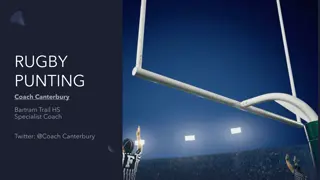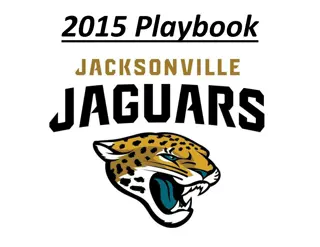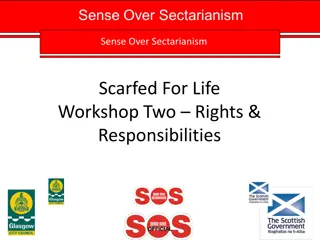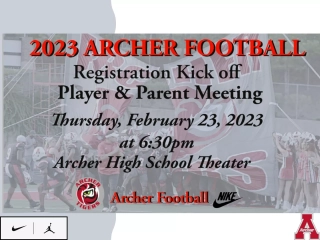Understanding Free Kicks in Football
The rules of free kicks in football define specific lines and distances for each team, such as the 6-1-1 line and the 40-yard line for a kickoff. Various scenarios like safety and fair catch determine the placement of the free kick line. Additionally, specific formation requirements, including player positions and distances, must be adhered to before the kick is taken.
Download Presentation

Please find below an Image/Link to download the presentation.
The content on the website is provided AS IS for your information and personal use only. It may not be sold, licensed, or shared on other websites without obtaining consent from the author. Download presentation by click this link. If you encounter any issues during the download, it is possible that the publisher has removed the file from their server.
E N D
Presentation Transcript
Free Kicks The Rules: 6-1-1 line, is established for each team. The lines are always 10 yards apart. Unless moved by penalty, K s free kick line is: For any free kick, a free kick line, corresponding to a scrimmage
Free Kicks The Rules: 6-1-1 line, is established for each team. The lines are always 10 yards apart. Unless moved by penalty, K s free kick line is: a. Its 40 yard line for a kickoff. For any free kick, a free kick line, corresponding to a scrimmage
Free Kicks The Rules: 6-1-1 line, is established for each team. The lines are always 10 yards apart. Unless moved by penalty, K s free kick line is: a. Its 40 yard line for a kickoff. b. Its 20 yard line after a safety. For any free kick, a free kick line, corresponding to a scrimmage
Free Kicks The Rules: 6-1-1 line, is established for each team. The lines are always 10 yards apart. Unless moved by penalty, K s free kick line is: a. Its 40 yard line for a kickoff. b. Its 20 yard line after a safety. c. The yard line through the spot of the catch following a fair catch. For any free kick, a free kick line, corresponding to a scrimmage
Free Kicks The Rules: 6-1-1 line, is established for each team. The lines are always 10 yards apart. Unless moved by penalty, K s free-kick line is: a. Its 40 yard line for a kickoff. b. Its 20 yard line after a safety. c. The yard line through the spot of the catch following a fair catch. d. The yard line through the spot of an awarded fair catch. For any free kick, a free-kick line, corresponding to a scrimmage
Free Kicks Rules (Continued): 6-1-3 the following formation requirements must be met: After the ball is marked ready for play, and until the ball is kicked,
Free Kicks Rules (Continued): 6-1-3 the following formation requirements must be met: a. No player, other than the kicker and holder for a place kick, may be beyond his free kick line. After the ball is marked ready for play, and until the ball is kicked,
Free Kicks Rules (Continued): 6-1-3 the following formation requirements must be met: a. No player, other than the kicker and holder for a place kick, may be beyond his free kick line. b. No K players, other than the kicker, may be more the 5 yards behind the kickers free kick line. After the ball is marked ready for play, and until the ball is kicked,
Free Kicks Rules (Continued): 6-1-3 the following formation requirements must be met: a. No player, other than the kicker and holder for a place kick, may be beyond his free kick line. b. No K players, other than the kicker, may be more the 5 yards behind the kickers free kick line. 6-1-4 At the time the ball is kicked, at least 4 players must be on each side of the kicker. After the ball is marked ready for play, and until the ball is kicked,
Free Kicks Rules (Continued): 6-1-3 the following formation requirements must be met: a. No player, other than the kicker and holder for a place kick, may be beyond his free kick line. b. No K players, other than the kicker, may be more the 5 yards behind the kickers free kick line. 6-1-4 At the time the ball is kicked, at least 4 players must be on each side of the kicker. 6-1-5 Any receiver may catch or recover a free kick in the field of play and advance, unless any R player has given a valid or invalid fair catch signal. R may catch or recover a free kick in K s end zone. After the ball is marked ready for play, and until the ball is kicked,
Free Kicks Rules (Continued): 6-1-3 the following formation requirements must be met: a. No player, other than the kicker and holder for a place kick, may be beyond his free kick line. b. No K players, other than the kicker, may be more the 5 yards behind the kickers free kick line. 6-1-4 At the time the ball is kicked, at least 4 players must be on each side of the kicker. 6-1-5 Any receiver may catch or recover a free kick in the field of play and advance, unless any R player has given a valid or invalid fair catch signal. R may catch or recover a free kick in K s end zone. 6-1-10 If a free kick goes out of bounds between the goal lines touched inbounds by R, the ball is put in play by R at the inbounds spot. After the ball is marked ready for play, and until the ball is kicked,
Free Kicks Rules (Continued): 6-1-3 the following formation requirements must be met: a. No player, other than the kicker and holder for a place kick, may be beyond his free kick line. b. No K players, other than the kicker, may be more the 5 yards behind the kickers free kick line. 6-1-4 At the time the ball is kicked, at least 4 players must be on each side of the kicker. 6-1-5 Any receiver may catch or recover a free kick in the field of play and advance, unless any R player has given a valid or invalid fair catch signal. R may catch or recover a free kick in K s end zone. 6-1-10 If a free kick goes out of bounds between the goal lines touched inbounds by R, the ball is put in play by R at the inbounds spot. 6-1-11 A pop-up kick is illegal. After the ball is marked ready for play, and until the ball is kicked,
Free Kicks Rules (Continued): 6-1-6 dead. It belongs to him unless it is kick-catching interference and R chooses an awarded fair catch or unless it is first touching. Any K player may recover the ball before it goes beyond R s free-kick line if it is touched first by any receiver. Such touching in the neutral zone by R is ignored if it is caused by K blocking or pushing R into contact with the ball or if K muffs the ball into contact with R. Any K player may recover a free kick if it has both touched the ground and goes beyond the plane of R s free-kick line. The two requirements may occur in any order. If any K player recovers or catches a free kick, the ball becomes
Free Kicks Rules (Continued): 6-1-6 belongs to him unless it is kick-catching interference and R chooses an awarded fair catch or unless it is first touching. Any K player may recover the ball before it goes beyond R s free-kick line if it is touched first by any receiver. Such touching in the neutral zone by R is ignored if it is caused by K blocking or pushing R into contact with the ball or if K muffs the ball into contact with R. Any K player may recover a free kick if it has both touched the ground and goes beyond the plane of R s free-kick line. The two requirements may occur in any order. 6-1-7 If any K player touches a free kick before it crosses R s free-kick line and before it is touched there by any R player, it is referred to first touching of a free kick. R may take the ball at the spot of first touching or any spot of first touching if there are more than one, or they may choose to put the ball in play as determined by the action which follows first touching. If any K player recovers or catches a free kick, the ball becomes dead. It
Free Kicks Rules (Continued): 6-1-8 a. A foul occurs prior to a change of possession and the penalty acceptance requires the replay of the down. b. There is a double foul. c. There is an inadvertent whistle during the kick. A free kick is not repeated unless:
Free Kicks Rules (Continued): 6-1-8 a. A foul occurs prior to a change of possession any the penalty acceptance requires the replay of the down. b. There is a double foul. c. There is an inadvertent whistle during the kick. 10-4-2 EXCEPTION: The basic spot may, at the option of the offended team, be the succeeding spot for fouls by K during a legal free kick or scrimmage kick down (other than kick catching interference) prior to the end of the kick when K will not be next to put the ball in play. A free kick is not repeated unless:
Free Kicks Rules (Continued): 6-1-8 a. A foul occurs prior to a change of possession any the penalty acceptance requires the replay of the down. b. There is a double foul. c. There is an inadvertent whistle during the kick. 10-4-2 EXCEPTION: The basic spot may, at the option of the offended team, be the succeeding spot for fouls by K during a legal free kick or scrimmage kick down (other than kick catching interference) prior to the end of the kick when K will not be next to put the ball in play. 6-1-9 A free kick shall not be kicked out of bounds between the goal lines untouched in bounds by R. If it is kicked out of bounds and R does not accept a penalty for kick-catch interference on the same kick as in 6-5-4, R has the following choices: a. Accept a five yard penalty from the previous spot and have K re-kick. b. Accept a five yard penalty from the succeeding spot. c. Put the ball in play at the inbounds spot 25 yards beyond the previous spot. d. Decline the penalty and put the ball in play at the inbounds spot. A free kick is not repeated unless:
Free Kicks Fair Catch: It is a fair catch and the ball is dead if any receiver gives a valid fair catch signal and catches a free kick in flight, in or beyond the neutral zone to R s goal line. If any other R player catches the ball after a valid or invalid signal is given, the ball is dead. Only the player giving a fair catch signal is given protection. Following a fair catch the offensive team may choose to free kick or snap anywhere between the hash marks on the yard line where the fair catch was made.
Free Kicks Kick Catching Interference: While any free kick is in flight in or beyond the neutral zone to R s goal line, K shall not; Touch the ball or R, unless blocked into the ball or R. Obstruct R s path to the ball. This is true even though no fair catch signal is given. The restriction ends when the ball goes beyond R restraining line and has touched the ground. The restriction also ends when R has touched the ball.
Free Kick Mechanics Seven Man Crew Referee, Head Linesman and Line Judge: Initial key is K1 on your side. If kick is to your zone take ball. Other officials key on blocks on K1s. R, move laterally to be in position to see action at the point of attack. When runner goes into a side zone observe blocks ahead of runner. Be alert for handoffs and reverses. H and LJ, stay at goal line until it is no longer threatened. When the runner is on your side of field, you are responsible for blocks at the point of attack and the runner. When the ball is on the other side of field, take a position to observe blocks on the backside of the runner. Field Judge and Side Judge: Have bean bag in hand. Know if the ball was kicked into the ground and bounced more than once. Allow all kicking team members to pass before moving down field 5-10 yards. Officiate kickers into receivers. Initial keys K2 and K3 on your side. Stay on keys until they are no threat to be fouled or to foul. Be prepared to cover goal line on long return. Umpire and Back Judge: Make certain all K players, except the kicker, is within the 5 yard belt before ready for play is sounded. Have bean bag in hand. Be alert for encroachment by kickers, on deep kick, officiate kickers restraining line as a line. After kick, move in to hash marks 5-10 yards downfield. Officiate kickers into receivers. Initial keys K4 and K5 on your side. Umpire is responsible for action on kicker. Officiate inside out.
Free Kick Mechanics Seven Man Crew-On-Side Kicks Referee: Position on R s 10 yard line, middle of field. Be alert to assist other crew members. If ball kicked deep, take over coverage of returner and blocks in immediate vicinity. Umpire and Back Judge: Position on K s restraining line. Have bean bag in hand. Be alert for encroachment by K. Officiate k s restraining line as a plane. Primarily responsible for pop-up kick. You have coverage of K s goal line. Secondarily responsible for illegal blocks by K and first touching by K. Field Judge and Side Judge: Position on R s restraining line. Have bean bag in hand. If kick is deep, promptly move down field to assist R. If short free kick, know whether kick crossed R s restraining line. Be alert for first touching by K. Be alert for fair catch signal by R. Be alert for kick catch interference by K. Head Linesman and Line Judge: Position on sideline between restraining lines. Have bean bag in hand. Be alert for first touching by K. Be alert for illegal blocks by K. Be alert for kick catching interference. Be alert for fair catch signal.
Free Kick Mechanics Five Man Crew Back Judge: Position K s restraining line opposite Press Box. Make sure kickers legally line up in 5 yard zone. Count K players. Have bean bag in hand. Clean-up sidelines. After kick, be alert for first touching by K. Be alert for kick that does not cross R s free kick line. On deep kicks, treat K s restraining line as a line. Move downfield slowly, not more the 10-15 yards. Key action on K players near R s restraining line. Key blocks ahead of runner. Be prepared to pick up runner from HL on long return. You have forward progress to goal line. Line Judge: Position on R s restraining line. Press Box side. Count K players. Have bean bag in hand. Clean-up sidelines. Raise hand above head to signal you are ready. After kick, be alert for first touching by K. Be alert for kick that does not cross R s restraining line. Watch initial blocks in your area. Move downfield slowly, not more the 10-15 yards. Key action on K players on your side of field ahead of runner. Be prepared to pick up runner from U on long return. You have forward progress to goal line.
Free Kick Mechanics Five Man Crew Head Linesman: Position on R s 30 yard line, opposite Press Box. Count R players. Assist BJ in cleaning-up sideline. Hold arm above head to signal you are ready. If kick goes out of bounds on your side mark spot. If kick is down the middle, watch blocks ahead of runner, be prepared to take over coverage from R if runner moves into your area. If kick is to your side, pick up runner and follow. If kick is to opposite side observe legality of blocks away from ball. Umpire: Position on R s 20 yard line, Press Box side. Count R players. Assist LJ in cleaning-up sideline. If kick goes out of bounds on your side mark spot. If kick is down the middle, watch blocks ahead of runner, be prepared to take over coverage from R if runner moves into your area. If kick is to your side, pick up runner and follow. If kick is to opposite side observe legality of blocks away from ball. Referee: Position on R s Goal line at inbounds mark on HL side of field. Count R players. After getting ready signs from crew, sound whistle to signal ready. Rule on kicks going into end zone or near end zone. If kick is down the middle, cover runner until releasing to other official. If kick is to opposite side observe legality of blocks away from ball. After releasing runner to other official, observe action of players in vicinity of runner. Serve as clean-up behind, to the side of and around runner.
Free Kick Mechanics Five Man Crew On- Side Kicks Back Judge: Position K s restraining line opposite Press Box. Make sure kickers legally line up in 5 yard zone. Count K players. Have bean bag in hand. Clean-up sidelines. Treat K s restraining line as a plane. Primarily responsible for pop-up kick. Primarily responsible for illegal blocks by K and first touching by K. You have coverage of K s goal line. Line Judge: Position K s restraining line Press Box side. Make sure kickers legally line up in 5 yard zone. Count K players. Have bean bag in hand. Clean- up sidelines. Treat K s restraining line as a plane. Primarily responsible for pop-up kick. Primarily responsible for illegal blocks by K and first touching by K. You have coverage of K s goal line. Head Linesman: Position on R s restraining line, opposite Press Box. Count R players. Have bean bag in hand. Clean-up sidelines. Know whether ball has crossed R s restraining line. Be alert for first touching by K. Be alert for fair catch signal. Be alert for kick catching interference. If ball kicked deep, retreat downfield to assist R with coverage.
Free Kick Mechanics Five Man Crew On- Side Kicks Umpire: Position on R s restraining line, Press Box side. Count R players. Have bean bag in hand. Clean-up sidelines. Know whether ball has crossed R s restraining line. Be alert for first touching by K. Be alert for fair catch signal. Be alert for kick catching interference. If ball kicked deep, retreat downfield to assist R with coverage. Referee: Position on R s 10 yard line, middle of field. Be alert to assist other crew members. If ball kicked deep, take coverage of returner and block in immediate vicinity.
Free Kick Mechanics Following A Fair Catch Seven Man Crew Umpire and Back Judge: Initial position on kicker s free kick line. You are responsible for determining that kicking team is on side at time of kick. Ensure Team K players are within 5 yards of their restraining line, and be alert that there are at least 4 players on each side of the kicker. Head Linesman and Line Judge: Initial position is on your sideline at goal line pylon. Field Judge: Initial position is on receiver's restraining line. You are responsible to see to it that receivers remain behind their restraining line until ball is kicked. Referee and Side Judge: Behind goal post. Side Judge responsible for cross bar. Ensure that there are at least 4 players on each side of the kicker when the ball is kicked. Rule on whether kick is successful.
Free Kick Mechanics Following A Fair Catch Five Man Crew Referee and Umpire: Behind goal post. Umpire responsible for cross bar. Ensure that there are at least 4 players on each side of the kicker when the ball is kicked. Rule on whether kick is successful. Back Judge: Position K s restraining line opposite Press Box. Be sure K does not encroach before kick. Line Judge: Position on R s restraining line. Press Box side. Be sure R does not encroach before kick. Head Linesman: Position on R s goal line, opposite Press Box.
